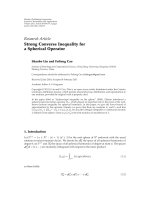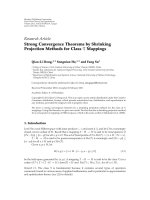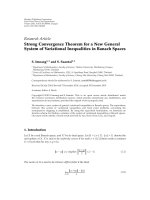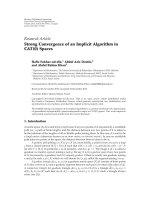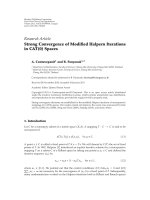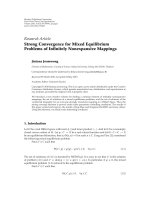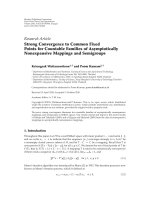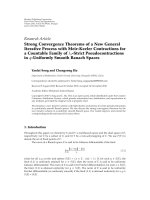Báo cáo hóa học: " Research Article Strong Converse Inequality for a Spherical Operator" pptx
Bạn đang xem bản rút gọn của tài liệu. Xem và tải ngay bản đầy đủ của tài liệu tại đây (473.51 KB, 7 trang )
Hindawi Publishing Corporation
Journal of Inequalities and Applications
Volume 2011, Article ID 434175, 7 pages
doi:10.1155/2011/434175
Research Article
Strong Converse Inequality for
a Spherical Operator
Shaobo Lin and Feilong Cao
Institute of Metrology and Computational Science, China Jiliang University, Hangzhou 310018,
Zhejiang Province, China
Correspondence should be addressed to Feilong Cao,
Received 2 July 2010; Accepted 8 February 2011
Academic Editor: S. S. Dragomir
Copyright q 2011 S. Lin and F. Cao. This is an open access article distributed under the Creative
Commons Attribution License, which permits unrestricted use, distribution, and reproduction in
any medium, provided the original work is properly cited.
In the paper titled as “Jackson-type inequality on the sphere” 2004, Ditzian introduced a
spherical nonconvolution operator O
t,r
, which played an important role in the proof of the well-
known Jackson inequality for spherical harmonics. In this paper, we give the lower bound of
approximation by this operator. Namely, w e prove that there are constants C
1
and C
2
such that
C
1
ω
2r
f, t
p
≤O
t,r
f − f
p
≤ C
2
ω
2r
f, t
p
for any pth Lebesgue integrable or continuous function
f defined on the sphere, where ω
2r
f, t
p
is the 2rth modulus of smoothness of f.
1. Introduction
Let
d−1
{x ∈
d
: |x| 1} d ≥ 3 be the unit sphere of
d
endowed with the usual
rotation invariant measure dωx.WedenotebyH
d
k
the space of all spherical harmonics of
degree k on
d−1
and Π
d
n
the space of all spherical harmonics of degree at most n.Thespaces
H
d
k
k 0, 1, are mutually orthogonal with respect to the inner product
f, g
:
d−1
f
x
g
x
dω
x
,
1.1
so there holds
Π
d
n
H
d
0
⊕H
d
1
⊕···⊕H
d
n
.
1.2
2 Journal of Inequalities and Applications
By C
d−1
and L
p
d−1
,1≤ p<∞, we denote the space of continuous, real-value functions
and the space of the equivalence classes of p-integrable functions defined on
d−1
endowed
with the respective norms
f
C
d−1
: max
μ∈
d−1
f
μ
,
f
p
:
d−1
f
μ
p
dω
μ
1/p
, 1 ≤ p<∞.
1.3
In the following, L
p
d−1
will always be one of the spaces L
p
d−1
for 1 ≤ p<∞,orC
d−1
for p ∞.
For an arbitrary number θ,0<θ<π, we define the spherical translation operator with
step θ as see 1, 2
S
θ
f
: S
θ
f; μ
1
d−2
sin
d−2
θ
μ·νcosθ
f
ν
dω
d−2
ν
,
1.4
where ω
d−2
means the d − 2-dimensional surface a rea of sphere embedded into
d−1
.Here
we integrate over the family of points ν ∈
d−2
whose spherical distance from the given point
μ ∈
d−1
i.e., the length of minor arc between μ and ν on the great circle passing through
them is equal to θ.ThusS
θ
f; μ can be interpreted as the mean value of the function f on
the surface of a d − 2-dimensional sphere with radius sin θ.
By the help of translation operator, we can define the modulus of smoothness of f ∈
L
p
d−1
as see 3,Chapter10 or 4
ω
r
f, t
p
: sup
0<θ
i
≤t
S
θ
1
− I
S
θ
2
− I
···
S
θ
r
− I
f
p
.
1.5
Clearly, the modulus is meaningful to describe the approximation degree and the smoothness
of f, which has been widely used in the study of approximation on sphere.
The Laplace-Beltrami operator Δ is defined by see 5, 6
Δf :
d
i1
∂
2
g
x
∂x
2
i
|x|1
,g
x
f
x
|
x
|
,
1.6
where |x| x
2
1
x
2
2
··· x
2
d
1/2
, x x
1
,x
2
, ,x
d
. We a lso need a K-functional on sphere
d−1
defined by see 3
K
2r
f; t
p
: inf
g∈C
2r
d−1
f − g
p
t
2r
Δ
r
g
p
,
1.7
where Δ
k
:Δ
k−1
Δ. For the modulus of smoothness and K-functional, the following
equivalent relationship has been proved see 3, Section 10.6
ω
2r
f, t
p
∼ K
2r
f, t
p
.
1.8
Journal of Inequalities and Applications 3
Throughout this paper, we denote by C
i
i 1, 2, the positive constants
independent of f and n and by Ca the positive constants depending only on a. Their value
will be different at different occurrences, even within the same formula. By A ∼ B we denote
that there are positive constants C
1
and C
2
such that C
1
B ≤ A ≤ C
2
B.
In 3, Ditzian introduced a spherical operator O
t,r
and used it to prove the well-known
Jackson type inequality for spherical harmonics. Before giving the definition of O
t,r
, we need
to introduce some preliminaries. Denote
T
ρ
f
x
: f
ρx
for ρ ∈ SO
d
,x∈
d−1
,
1.9
where SOd denotes the group of orthogonal matrices on
d
with determinants 1. We denote
further
Δ
2r
ρ
f
x
:
T
ρ
− 2I T
ρ
−1
r
f
x
.
1.10
For an orthogonal matrix Q with determinant 1, we define
M
t, Q
: Q
−1
⎛
⎜
⎜
⎜
⎜
⎜
⎜
⎜
⎜
⎜
⎝
cos t sin t 00··· 0
− sin t cos t 00··· 0
0010··· 0
··· ··· ··· ··· ··· ···
0000··· 1
⎞
⎟
⎟
⎟
⎟
⎟
⎟
⎟
⎟
⎟
⎠
. 1.11
Now we are in the position to define the operator O
t,r
.Atfirstwedefinetheaveraging
operator A
t,r
f by see 3
f − A
t,r
f :
1
2r
r
Q∈SOd
Δ
2r
Mt,Q
fdQ,
1.12
where dQ represents the Haar measure on SOd normalized so that
Q∈SOd
dQ 1,
1.13
where the definition of the Haar measure can be found in 7.Furthermore,forameasure
μ
t
u supported in 0,tt being fixed and u is the variable such that
dμ
t
u1dμ
t
u0
for u>|t|, the operator O
t,r
is defined by
O
t,r
f :
A
u,r
f
x
dμ
t
u
. 1.14
4 Journal of Inequalities and Applications
In 3, Ditzian gave a converse inequality for O
t,r
as follows.
Theorem A. For any f ∈ L
p
d−1
, 1 ≤ p ≤∞, and some fixed η>1, there holds
C
−1
f − O
t,r
f
p
≤ K
2r
f; t
p
≤ C
f − O
t,rf
p
f − O
ηt,r
f
p
. 1.15
In this paper, we improve this result. Motivated by 8, 9, we obtain the following
Theorem 1.1.
Theorem 1.1. For any f ∈ L
p
d−1
, 1 ≤ p ≤∞, there holds
O
t,r
f − f
p
∼ ω
2r
f, t
p
∼ K
2r
f, t
p
.
1.16
2. The Proof of Main Result
Before proceeding the proof, we state some useful lemmas at first. The first one can be find in
3,page6.
Lemma 2.1. For any f ∈ L
p
d−1
, 1 ≤ p ≤∞, there exists a constant Cr depending only on r
such that
O
t,r
f
p
≤ C
r
f
p
.
2.1
The following three lemmas reveal some important properties of O
t,r
f. Their proofs
can be found in 3,Theorem6.1, 3,Theorem6.2,and3,equation4.8, respectively.
Lemma 2.2. For f ∈ L
p
d−1
, 1 ≤ p ≤∞,andm ≥ 2k,onehas
Δ
k
O
m
t,r
f
p
≤
C
k
t
2k
O
m−2k
t,r
f
p
,
2.2
where O
m
t,r
f : O
m−1
t,r
O
t,r
f.
Lemma 2.3. For g ∈ C
2r2
d−1
,and1 ≤ p ≤∞, there holds
O
t,r
g − g − t
2r
P
r
Δ
g
p
≤ Ct
2r2
Δ
r1
g
p
,
2.3
where P
r
Δ :
r
i1
a
i
Δ
i
g is a polynomial of degree r in Δ.Moreover,P
r
Δg 0 only for g
const.
Lemma 2.4. For any g ∈ C
2r2
d−1
,anyk ≤ r,andm ∈ , there holds
O
m
t,r
Δ
k
f Δ
k
O
m
t,r
f.
2.4
Journal of Inequalities and Applications 5
From 1.8 and 10,Theorem3.2see also 3,page16 we deduce the following
Lemma 2.5 ea sily.
Lemma 2.5. Let P
r
Δ be defined in 2.3 and 1 ≤ p ≤∞, then one has
K
2r
f, t
p
∼ ω
2r
f, t
p
∼ inf
g∈C
2r
f − g
p
t
2r
P
r
Δ
g
p
.
2.5
Now, we give the last lemma, which can easily be deduced from 10,Theorem3.1.
Lemma 2.6. Let P
r
Δ be defined in 2.3 and 1 ≤ p ≤∞, then one has
t
2r2
Δ
r1
O
m
t,r
f
p
≤ Ct
2r
P
r
Δ
O
m−2
t,r
f
p
.
2.6
We now give the proof of Theorem 1.1. It has been shown in 1.15 and 1.8 that there
exists a constant C
1
such that
f − O
t,r
f
p
≤ C
1
ω
2r
f, t
p
,
2.7
hence we only need to prove that there exists a constant C
2
such that
ω
2r
f, t
p
≤ C
2
f − O
t,r
f
p
.
2.8
From 2.5 it is sufficient to prove that, for m ≥ 2r 1, there holds
f − O
m
t,r
f
p
t
2r
P
r
Δ
O
m
t,r
f
p
≤ C
3
f − O
t,r
f
p
.
2.9
In order to prove 2.9,wefirstprove
f − O
m
t,r
f
p
≤ C
m
f − O
t,r
p
.
2.10
6 Journal of Inequalities and Applications
Indeed, from 2.1,wehave
f − O
m
t,r
f
p
≤
f − O
t,r
f
p
m−1
k1
O
k
t,r
f − O
k1
t,r
f
p
≤
f − O
t,r
f
p
m−1
k1
O
k
t,r
f − O
t,r
f
p
≤
f − O
t,r
f
p
C
m−1
k1
O
k−1
t,r
f − O
t,r
f
p
≤···≤
f − O
t,r
f
p
C
m−1
k1
O
t,r
f − O
t,r
f
p
≤ C
m
f − O
t,r
f
p
.
2.11
Now we turn to prove
t
2r
P
r
Δ
O
m
t,r
f
p
≤ C
4
f − O
t,r
f
p
.
2.12
In fact, from 2.3,weobtain
t
2r
P
r
Δ
O
m
t,r
f
p
≤
O
t,r
O
m
t,r
f
− O
m
t,r
f
p
C
5
t
2r2
Δ
r1
O
m
t,r
f
p
.
2.13
In order to estimate t
2r2
Δ
r1
O
m
t,r
f
p
,weuse2.6 and obtain that
t
2r2
Δ
r1
O
m
t,r
f
p
≤ Ct
2r
P
r
Δ
O
m−2
t,r
f
p
≤ Ct
2r
P
r
ΔO
m
t,r
f
p
Ct
2r
P
r
Δ
O
m
t,r
f − P
r
Δ
O
m−2
t,r
f
p
≤ Ct
2r
P
r
Δ
O
m
t,r
f
p
Ct
2r
a
r
Δ
r
O
m−2
t,r
f − O
2
t,r
f
p
Ct
2r
a
r−1
Δ
r−1
O
m−4
t,r
O
2
t,r
f − O
4
t,r
f
p
··· Ct
2r
a
1
ΔO
m−2r
t,r
O
2r−2
t,r
f − O
2r
t,r
f
p
.
2.14
Journal of Inequalities and Applications 7
Using 2.2 again and 2.10,wehave
t
2r2
Δ
r1
O
m
t,r
f
p
≤ Ct
2r
P
r
Δ
O
m
t,r
f
p
C
r
O
m−2−2r
t,r
f − O
2
t,r
f
p
C
r−1
t
2
O
m−2r−2
t,r
O
2
t,r
f − O
4
t,r
f
p
··· C
1
t
2r−2
O
m−2r−2
t,r
O
2r−2
t,r
f − O
4
t,r
f
p
≤ Ct
2r
P
r
Δ
O
m
t,r
f
p
C
f − O
t,r
f
p
.
2.15
The above inequality together with 2.13 and 2.10 yields 2.12. Then we can deduce 2.9
from 2.12 and 2.10 easily. Therefore 2.8 holds. This completes the proof of Theorem 1.1.
Acknowledgment
The research was supported by the National Natural Science Foundation of China no.
60873206.
References
1 W. Rudin, “Uniqueness theory for Laplace series,” Transactions of the A merican Mathematical Society,
vol. 68, pp. 287–303, 1950.
2 H. Berens, P. L. Butzer, and S. Pawelke, “Limitierungsverfahren v on Reihen mehrdimensionaler
Kugelfunktionen und deren Saturationsverhalten,” Publications of the Research Institute for Mathemati-
cal Sciences, vol. 4, pp. 201–268, 1968.
3 Z. Ditzian, “Jackson-type inequality on the sphere,” Acta Mathematica Hungarica, vol. 102, no. 1-2, pp.
1–35, 2004.
4 Kh. P. Rustamov, “On the equivalence of different moduli of smoothness on the sphere,” Proceedings
of the Steklov Institute of Mathematics, vol. 204, no. 3, pp. 235–260, 1993.
5 K. Wang and L. Li, Harmonic Analysis and Approximation on the Unit Sphere , Science Press, Beijing,
China, 2000.
6 C. M
¨
uller, Spherical Harmonics,vol.17ofLecture Notes in Mathematics, Springer, Berlin, Germany, 1966.
7 R. A. DeVore and G. G. Lorentz, “Constructive Approximation,” Grundlehren Math. Wiss., vol. 303,
Springer, 1993.
8 F. Dai and Z. Ditzian, “Strong converse inequality for Poisson sums,” Proceedings of the American
Mathematical Society, vol. 133, no. 9, pp. 2609–2611, 2005.
9 R. Y. Yang, F. L. Cao, and J. Y. Xiong, “The strong converse inequalities for de la Va ll
´
ee Poussin means
on the sphere,” Chinese Journal of Contemporary Mathematics, In press.
10 Z. Ditzian and M. Felten, “Averages using translation induced by Laguerre and Jacobi expansions,”
Constructive Approximation, vol. 16, no. 1, pp. 115–143, 2000.

